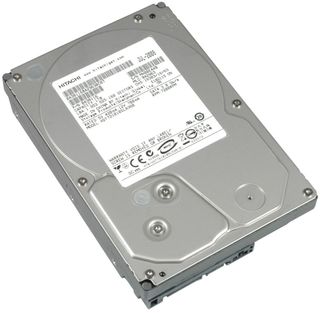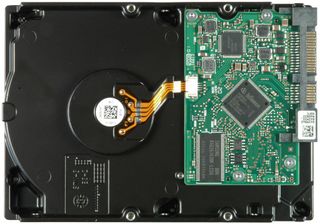Acoustically Manage Your Hard Drive
Hitachi Deskstar 7K1000.B

Most readers should be familiar with the Hitachi Deskstar 7K1000.B, which has been Hitachi’s top model for a few months. Compared to its predecessor, the 7K1000 (without the B) , it delivers considerably better throughput of up to 111 MB/s and much better application performance. It is now based on only three storage platters rather than on the five-platter design leveraged by the original 7K1000. Hitachi upgraded its warranty for retail products, resulting in a five-year factory warranty, which is also the case for Seagate and WD upper mainstream drives. You can check the warranty status of your Hitachi drive on the Hitachi website.

Although we used a 1 TB Deskstar 7K1000.B, you can choose among several different capacity points and get the same excellent feature set, starting at 160 GB. Most of the drives come with 16 MB cache memory, and all utilize a SATA/300 interface with Native Command Queuing. Hitachi also has models that come with built-in, real time data encryption, called Bulk Data Encryption (BDE) .
All statements we make about acoustic management are also valid for the other models, but the exact results may not necessarily apply, since lower capacity drives come with one or two storage platters instead of three. This has an influence on idle noise as well as on access noise, as there are fewer heads to be relocated.

We found that the latest Deskstar 7K1000.B is a very balanced drive and hence is suitable as a system drive. It delivers nice application performance, throughput that is above the average, and reasonable power consumption. As a result, the drive provides nice performance per watt results. Other terabyte drives, such as the Samsung Spinpoint F, provide higher throughput, and a WD Caviar Black is the faster application drive. But no hard drive is perfect, and the differences are in fact small.
Let’s look at the results with AAM set to either “fast” or “quiet. ”
Stay on the Cutting Edge
Join the experts who read Tom's Hardware for the inside track on enthusiast PC tech news — and have for over 25 years. We'll send breaking news and in-depth reviews of CPUs, GPUs, AI, maker hardware and more straight to your inbox.
Current page: Hitachi Deskstar 7K1000.B
Prev Page Acoustic Management: How It Works Next Page Acoustic Management MeasurementsMost Popular

